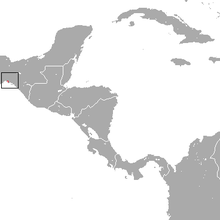Tehuantepec bunny
| Tehuantepec bunny | ||||||||||||
|---|---|---|---|---|---|---|---|---|---|---|---|---|
| Systematics | ||||||||||||
|
||||||||||||
| Scientific name | ||||||||||||
| Lepus flavigularis | ||||||||||||
| Wagner , 1844 |
The Tehuantepec hare ( Lepus flavigularis ) is a species of mammal belonging to the genus of the real hares within the lagoon group . Its range is limited to a very small area in southern Mexico .
features
The Tehuantepec hare reaches a body length of 56.5 to 61.0 centimeters and a tail length of 6.5 to 9.5 centimeters. The feet are 11.5 to 13.4 inches long and the ears 10.7 to 11.9 inches. The body color is light ocher to sandy brown with black interspersed. The ears are also sand-colored, but in contrast to the white-flanked hare ( Lepus callotis ), they have a black spot at the top. The neck is drawn by two dark stripes and a sand-colored stripe between them, which arise behind the ears. The throat is yellowish, the belly and the flanks are white like the white flanked hare and the abdomen is iron gray.
distribution and habitat
The distribution area of the Tehuantepec hare is limited to a very small area in southern Mexico on the isthmus of Tehuantepec . It ranges from Salina Cruz in the state of Oaxaca to the far west of the state of Chiapas , although the species has not been sighted in the latter in recent years. The known distribution area thus covers an area of around 150 km 2 , the real distribution probably being a maximum of 100 km 2 . Historically, a total distribution area of a maximum of 5,000 km 2 is assumed.
The Tehuantepec hare lives mainly in the coastal lowlands up to a maximum of 500 meters. Its habitat is limited to open grassland with bushes and cacti of species such as Byrsonima crassifolia , Opuntia decumbens , Opuntia tehuantepecana and trees such as Crescentia or the Mexican palm Sabal mexicana as well as grassy dunes. The predominant grasses are species of the genera Paspalum and Bouteloua . These habitats never extend further than four to five kilometers from the coast of the Gulf of Tehuantepec into the hinterland.
Way of life
The Tehuantepec hare is strictly crepuscular and nocturnal and therefore only searches for food in the evening and at night. In its distribution area it is partly sympathetic with the Florida cottontail ( Sylvilagus floridanus ). Like other species of rabbit, the Tehuantepec rabbits also feed on grass and other green plants.
Reproduction
Little data is available on the reproduction of the hare. The mating season probably lasts from February to December, with a peak in the rainy season between May and October. The animals are likely polygamous . The females give birth to between one and four, usually two young animals per litter. The underlying data, however, do not come from observations, but were obtained through investigations on preserved museum specimens at the Universidad Nacional Autónoma de México . The animals reach sexual maturity after six to seven months .
Systematics
The Tehuantepec hare is assigned to the real hare (genus Lepus ) as an independent species . There is probably a close relationship to the white-flanked hare ( Lepus callotis ), which it resembles in its appearance, and the donkey hare ( Lepus californicus ).
Hazard and protection
The species is rated by the International Union for Conservation of Nature and Natural Resources (IUCN) as "Endangered" due to the population size and the very limited habitat. The decline in the population due to the progressive destruction of habitat through conversion into agricultural land has been more than 50% over the last few years and the occurrence of the species is now limited to an area of no more than 100 km 2 . In total, only four isolated and very small populations of the Tehuantepec hare exist and the total population is estimated to be less than 1,000 individuals.
supporting documents
- ↑ a b Fernando A. Cervantes: Lepus flavigularis . In: Mammalian Species . tape 423 , 1993, pp. 1–3 ( full text (PDF; 319 kB)).
- ↑ a b c Joseph A. Chapman, John EC Flux (Ed.): Rabbits, Hares and Pikas. Status Survey and Conservation Action Plan. (PDF; 11.3 MB) International Union for Conservation of Nature and Natural Resources (IUCN), Gland 1990. ISBN 2-8317-0019-1 .
- ↑ a b c d e Lepus flavigularis in the endangered Red List species the IUCN 2011. Posted by: FA Cervantes, C. Lorenzo, V. Farias, J. Vargas, 2008. Accessed January 23, 2012 Design.
literature
- Fernando A. Cervantes: Lepus flavigularis . In: Mammalian Species . tape 423 , 1993, pp. 1–3 ( full text (PDF; 319 kB)).
- Joseph A. Chapman, John EC Flux (Eds.): Rabbits, Hares and Pikas. Status Survey and Conservation Action Plan. (PDF; 11.3 MB) International Union for Conservation of Nature and Natural Resources (IUCN), Gland 1990. ISBN 2-8317-0019-1 .
Web links
- Lepus flavigularis in the endangered Red List species the IUCN 2011. Posted by: FA Cervantes, C. Lorenzo, V. Farias, J. Vargas, 2008. Accessed January 23, 2012 Design.
